AMD Radeon HD 7990 Review: 7990 Gets Official
by Ryan Smith on April 24, 2013 12:01 AM EST- Posted in
- GPUs
- AMD
- Radeon
- Radeon HD 7000
- Tahiti
Power, Temperature, & Noise
As always, last but not least is our look at power, temperature, and noise. Next to price and performance of course, these are some of the most important aspects of a GPU, due in large part to the impact of noise. All things considered, a loud card is undesirable unless there’s a sufficiently good reason – or sufficiently good performance – to ignore the noise.
AMD for their part is clearly focusing on all of this with the 7990, both compared to the 6990 before it, and to the alternative unofficial 7990s that are already on the market. On the power front their binning has enabled them to get a dual-GPU Tahiti card out at 375W. Meanwhile on the temperature front, the style of open air cooler used on the 7990 typically affords good-to-great thermal performance with very little noise for the performance. AMD has measured their 7990 as being even quieter than GTX Titan, so we’ll see just how that pans out in our tests.
| Radeon HD 7990 Voltages | ||||
| 7990 Max Boost | 7990 Base | 7990 Idle | ||
| 1.2v | 1.17v | 0.85v | ||
With AMD binning chips to put together the 7990, it comes as no surprise that voltages are lower than the 7970GE. The load voltage in the 1GHz boost state is 1.2v, and it drops to 1.17v for 950MHz. This coupled with the lower leakage aspects of AMD’s selected GPUs is where the bulk of the hard work is done in keeping 7990’s power consumption down.
Normally this is the part where we look at voltage versus clockspeed in-depth, but as Tahiti is an older PowerTune 1.0 part, it’s still based around a handful of DPM states with a number of inferred states in between. As a result we don’t have a good idea of what the 7990 is running at for clockspeeds at any given moment; only that it frequently jumps between the boost state and the high state in most games. Looking at our performance relative to the 7970GE CF, the performance gap in most games is clearly larger than the clockspeed gap, so the 7990 is likely spending much of its time at 950MHz or lower.
This is also a loss for AMD of course, since they have to maintain their 1.2/1.17v voltages even at throttled clockspeeds. ZeroCore made idle power on the 7990 interesting, and in the next generation of AMD GPUs PowerTune 2.0 should have a noticeable impact on clockspeeds and power consumptions.
On a final note before jumping into our results, although our PowerColor 7990 was a loaner for the Titan launch and has since been returned – and as such we can’t update the performance results – the power/temp/noise results are still valid. So in our forthcoming results we’ll also be looking at how the official 7990 compares to its officially unofficial predecessor.

Idle power consumption is a bit of a head-scratcher at first. Power consumption is clearly down versus the 6990, and even the GTX 690 draws 5W more at the wall. On the other hand it’s 12W higher than the 7970GE CF. To be clear here the 2nd GPU is definitely powering down on the 7990 – there’s actually a small green LED on the back of the card to indicate when ZeroCore is active – so what we’re seeing is the power consumption of the first GPU, the trickle of power the second GPU pulls, and then everything else.
Among other things the 7990 doesn’t get to power its fans down like the second card in a CrossFire configuration does, so that’s part of the difference. Furthermore there’s the PLX bridge on the 7990 that has to be accounted for, and any differences due to the use of Volterra VRMs. Finally there’s the dumb luck component: some GPUs and cards are just better than others, and this goes for both load and idle.
In any case, despite our initial surprise the 7990 is still the clear winner here as far as dual-GPU cards go. It’s not as low as what we were initially expecting, but it has clearly improved over both the 6990 and PowerColor’s 7990.
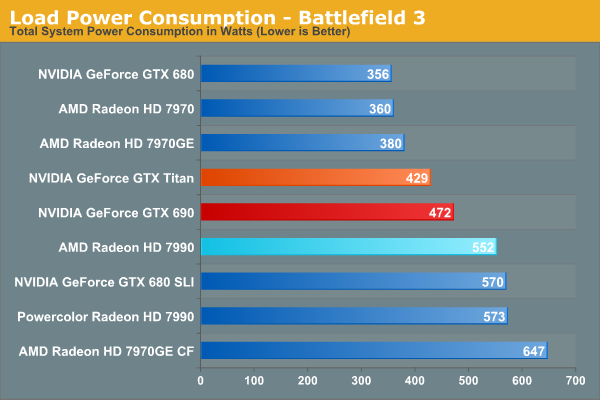
Moving on to load power, the 7990 draws right about what we expected it to. The 7990 is a 375W card, and indeed it’s drawing about 75W more than its closest competition, the 300W GTX 690. For AMD this is a mixed blessing, as it means they have 75W more thermal headroom to play with to outperform the competition, but it also means they need to actually deliver that performance to justify the power difference. In BF3 that’s not what we saw at 2560 and 5760, but of course the leader and the performance gap between the GTX 690 and 7990 changes on a per-game basis.
In any case, PowerTune and AMD’s binning are making their presence felt here. For its slightly lower performance the 7990 draws almost 100W less than the 7970GE CF at the wall, and compared to the PowerColor 7990 it’s still 21W less.
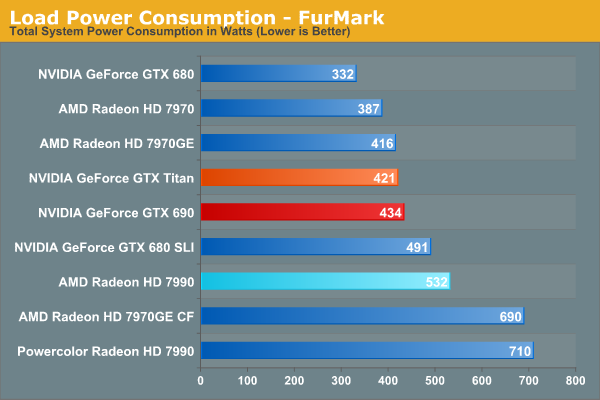
FurMark ended up being harder on the 7990 than we expected. Both NVIDIA and AMD throttle it of course, but we’ve never seen it throttled so hard as on the 7990. The 7990 completely stalled at times and momentarily dropped to its medium power state (500MHz) while running FurMark. The results are still enlightening since we’re clearly hitting it peak power limits regardless, but it’s not a very good sustained load in this case.
Nevertheless our power measurements were roughly as expected. Discounting the difference between AMD and NVIDIA in throttling, compared to the 7970GE CF and PowerColor 7990 the difference is 160W-180W in savings. For the slight performance loss this is a very good tradeoff and a clear example of why it’s so important AMD got into the multi-GPU game on the 7000 series, as this can only be achieved by careful binning by the GPU manufacturer.
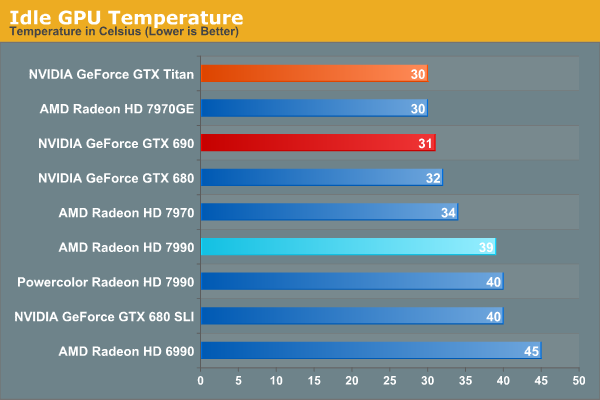
When it comes to idle temperatures the 7990 is decent, but it’s nothing particularly fantastic. 39C is warmer than what we typically see with open air cards, and for that matter it’s warmer than GTX 690 despite the latter’s higher power draw. On the other hand it’s another clear improvement over the 6990, which idles at 45C.
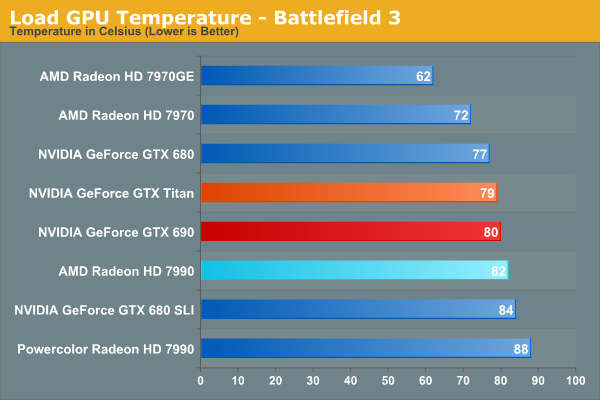
As for load temperatures, open air coolers have proven to be quite capable, but of course a lot depends on how the card has been tuned. For multi-GPU cards 80C+ is simply a given to maximize performance and minimize noise, and indeed that’s exactly what we’re seeing here. 82C puts the 7990 in the company of both the GTX Titan and GTX 690, which is good company to be in. 82C is well below the limit for Tahiti, and as an added bonus for overclockers this means there’s at least some thermal headroom to play with.
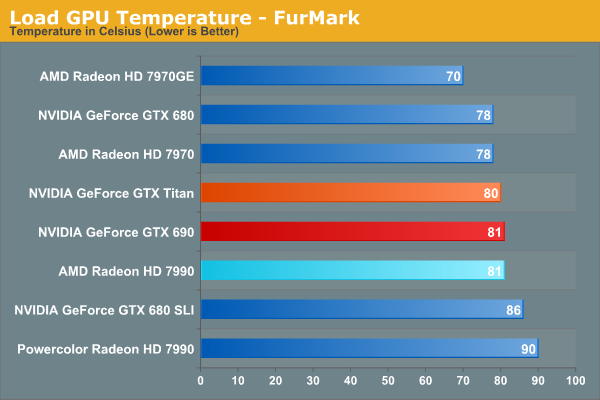
Furmark provides us with similar temperatures. It’s actually a bit cooler than under BF3 due to the inconsistent load presented by AMD’s heavy throttling, but it’s not too far off the mark. It is a good reminder however of another one of the benefits of a single card over multiple cards in CrossFire in a tight case: nothing is getting suffocated by a second card.
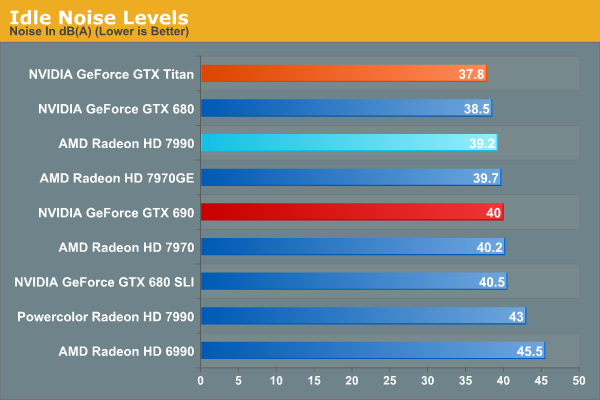
Finally we’re to our look at noise levels, one of the areas AMD has heavily focused on and is rather proud of. The 6990 was a beast at both idle and load, so there’s a lot of room and a lot of need for improvement here. When it comes to idle AMD has clearly met their mark; 39.2dB is essentially in the whisper quiet area, and is actually marginally quieter than the open air cooled 7970GE we use. It’s even a bit quieter than the GTX 690, if only by 0.8dB. Compared to the 45.5dB 6990 it’s a massive difference; it’s nearly ¼ the noise in terms of power.
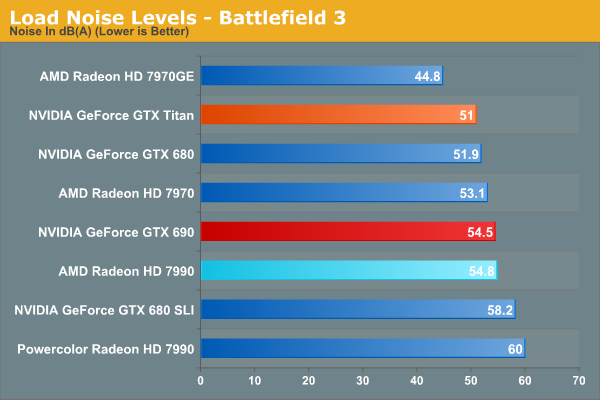
Moving on to load noise however and things become more of a mixed bag than a straight-up victory. Once more AMD has greatly improved over the 6990; though we can’t plot it on this chart, in our old gaming noise test the 6990 hit 66dB in both game and pathological testing. So 54.8dB is downright quiet in comparison. Overall this is louder than our high-end single-GPU cards such as the 7970 and GTX 680, but it’s otherwise an improvement over the likes of the GTX 680 SLI and PowerColor 7990.
The downside here for AMD is that their goal was to beat Titan on noise; by our reckoning they’re well off the mark. 3.8dB isn’t an extreme difference, but it’s a very real difference. 7990 isn’t quieter than Titan, and in fact it’s essentially tied with 690. Now 690 was a quiet card for a dual-GPU card and 7990 joins it in that club, so this is still a good result for the 7990. It’s just not what they were shooting for.
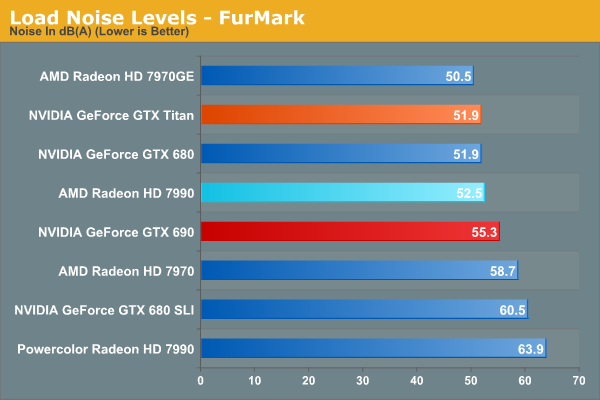
Noise measurements under FurMark end up being a wash due to the inconsistent load presented by AMD’s throttling on the 7990. 55.3 is about right for the GTX 690 at its peak; 52.5 just isn’t right for the 7990 since we hit 54.8dB with BF3. However pulling in this data does draw out something else: the 7990 at its loudest is quieter than the reference 7970, by nearly 4dB. We’re ultimately comparing a full blower to an open air cooler, but the difference is still staggering.
Ultimately AMD hasn’t been able to best Titan in our noise measurements, but that just makes 7990 among the quietest multi-GPU cards we’ve ever tested. We’ll break down the messy issue of power versus performance in our conclusion, but for now it’s clear that AMD has delivered most of their noise goals with the 7990, making the 7990 an incredible improvement over the 6990 and the PowerColor 7990.


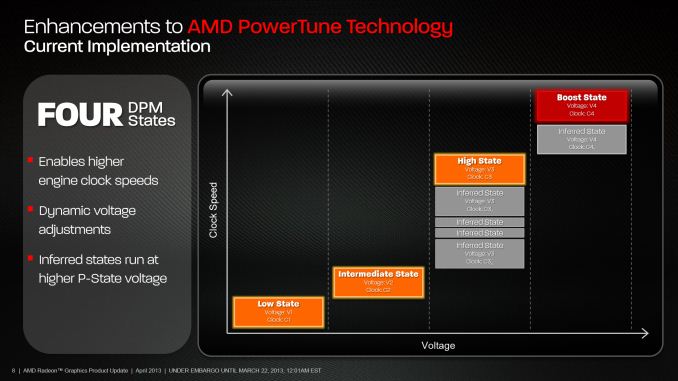








91 Comments
View All Comments
TheJian - Saturday, April 27, 2013 - link
I said a week or two ago you'd find an excuse to leave out fcat...LOL. You did. Even come up with a problem nobody else has, and show a large boost to AMD that places like tomshardware don't show while showing NV cards slower than their benchmarks in the exact same games and resolutions.Just like the percent gains in the driver post a few days ago (as I posted all of your %'s were lower than NV's own page which I linked to), you have NV scoring lower than other reviews.
http://www.anandtech.com/show/6913/nvidia-r319-ser...
Read the last comment people...They seem to lie a lot here and it's not surprising AMD chose to talk ONLY to this site recently and avoided access even to these guys to the driver team working on the "ISSUES" AMD has.
Heck toms last page title is this:
"Can The World’s Best Bundle Save Radeon HD 7990?"
ROFL...That pretty much sums up what they found...AMD sucks currently when FCAT is thrown in the picture.
But even leaving that out they put 5 gamers in a pepsi/coke style blind play test. ALL 5 CHOSE NV 690 gtx as the better card. They even note both Titan and 690GTX gave a better gaming experience.
It's funny you didn't mention what tom's found with noise:
"It’s only unfortunate that power-related vibrations generate more volume than the coolers themselves."
hmmm....
I guess you guys will keep claiming something about fcat problems until AMD solves their issues just as I've said before. This site is really losing credibility.
http://www.tomshardware.com/reviews/radeon-hd-7990...
http://www.pcper.com/reviews/Graphics-Cards/AMD-Ra...
"Perhaps they are using multiple displays for Eyefinity/Surround setups - in that case, the HD 7990 has different but equally traumatic problems. In our testing, nearly every other frame generated by all of our games tested are dropped and never shown to the gamer, resulting in frame rates at about half of what they should be and half of what is being reported by some other testing methods. That's just not acceptable. We are working on another story that directly compares the issues of Eyefinity and Surround that we hope to have up by next week along with some videos to demonstrate those complicated issues. "
Other people draw the exact OPPOSITE conclusions from this site's conclusions...LOL. “traumatic problems” in multi-monitor setups is a pretty harsh thing to say correct?
But then you come up with this zinger:
"As we’ve seen in the past AMD does a bit better than NVIDIA at multi-monitor resolutions, so while the 7990 trails the GTX 690 at 2560, it immediately jumps ahead at 5760."
From your shogun page...How much does AMD pay you guys to say complete opposites of other review sites using FCAT results? Are they completely funding your site at this point or what?
"It’s not a problem at this moment, but 2GB at multi-monitor resolutions in particular is going to be a wall very soon, and 2560 may not be too far behind. 2GB per GPU was reasonable in 2012, but now it’s a year later and things change. So for as little as we can predict something to be future-proof, AMD certainly seems to have an edge."
Yeah, get back to me when you're not making up stuff that isn't happening. As toms 5 gamers showed, NV was better all around and all 5 chose NV without knowing which was which. That kind of data matched their FCAT results exactly, even with the beta2 latest driver and the Prototype driver that won't be out until who knows when. After Q2 isn't specific...that could mean 2014. While the prototype driver helped at toms they still had issues and the gamers still chose NV even after testing again with prototype.
“But when we combine the quantitative data enabled by video capture-based performance analysis and the subjective judgments of a panel of gaming enthusiasts who simply want to play their favorite titles on the best hardware possible, Nvidia’s thousand-dollar GeForce GTX 690 outshines the similarly-priced Radeon HD 7990. Our early look at AMD’s prototype driver suggests that more evenly pacing the rate at which frames are shown on-screen helps minimize frame time variance, which our gamers definitely noticed. But that release isn’t expected for months—the second half of 2013 is as specific as AMD gets.”
Also, you tested all the way to 5760...Memory isn't a problem and won't be for a long time (don’t forget the titan has 6GB!). They don't program games for cards that barely exist. I'm guessing this is a limited run just like asus' card only had 1000, unlike NV's first titan run which was 100,000 and is sold out still today after more runs...LOL.
Without the games as incentive toms gives this on the conclusion page:
“And so we’re faced with a card that represents a huge improvement over its predecessor, but still comes up shy of its competition, and is priced like an equal.”
The games get old or I already have them. But I have to live with the card itself (especially at these prices) for probably 4-5 years or maybe more.
“For buyers that have faith in multi-GPU scaling and AMD’s ability to deliver timely profile updates the 7990 can and will handily surpass Titan by about 20%”
Umm…Have you read Hardocp’s driver review of AMD’s situation for the last year? They were 6 months late on some game optimizations and it took them a year to get drivers even near right and Enduro still sucks according to notebookcheck’s 7970 rehash review.
http://www.hardocp.com/article/2013/03/04/2012_amd...
They paint a pretty POOR driver picture for a year for AMD. While you’re there read their review of the 7990 which also points to multimonitor problems:
“We have sent our experiences to AMD, and hopefully there will be a fix in the future and then we can bring you TressFX performance under Eyefinity and CrossFire.”
LOL. But you think it’s all good with multi-monitor’s and think the memory future proofs it eh ryan? Everyone else thinks it sucks and has issues. Comically they found a slide showing AMD claiming to be able to do 3840x2160 in tombraider. They couldn’t get it to run there at all:
“AMD is claiming playable performance in Tomb Raider with TressFX enabled at a resolution of 3840x2160. We wanted to test this ourselves, and found where Tomb Raider stores its graphics settings in the registry. We attempted to force 3840x2160, unfortunately the game would not start at this resolution.” Followed by this little gem, “Therefore, we find it highly unlikely that AMD's claim is valid.” Well ok then. They made the same claim for crisis 3…Which again Hardocp attempted to prove (right or wrong):
“Above is our run-through at "max settings" at 3840x2160. You can clearly see that performance is very poor on the AMD Radeon HD 7990. The minimum framerate is 10 FPS, and the average is 19.4 FPS, well under 30 FPS. This level of performance is not playable in Crysis 3.”…Well ok then…Another lie shot down eh? “This claim is clearly invalid.”
Yeah, we hear you loud and clear. Two AMD claims, two AMD lies. It didn’t even work with 1.3mil pixels less res of 5760x1200 for them. They got below 30fps.
Farcry note: “GeForce GTX 680 SLI has the lowest framerates, but the smoothest overall experience thanks to SLI's non-stutter gameplay compared to CrossFire in this particular title.”
Yeah, that’s kind of what tomshardware and their 5 game players said. No stutter=BETTER gameplay.
And when they found your memory claim kicking in:
“Hitman is sensitive to VRAM capacity. In this case, the AMD Radeon HD 7990 and Radeon HD 7970 GHz Edition CrossFire have the advantage thanks to the larger 3GB of VRAM per GPU. GeForce GTX 680 SLI only has 2GB per GPU.”
“The drops in performance make gameplay not possible because it hitches and lags behind as you are playing.”
So when your situation actually happens, it isn’t playable already anyway…LOL Not the minimums on all cards were under 3fps…LOL. That’s not a type man, it’s they all scored 1, 2 & 3 fps…ROFL. But you keep trying to help AMD any way you can ryan…They need it…LOL.
Their conclusion page:
“Hopefully after reading this evaluation you've come to the same question we have, "Where's the missing performance?"….So the card sucks then there too? They even manually turned up powertune 20% and got the same results. And again another site saying it: “Quite simply, AMD CrossFire is the stutterer in the room.” Yeah we know the 5 gamers said the same at toms. His 680 GTX experience however is described as this on the same page:
“I was in awe. It felt smooth, really smooth, it felt like it was running at a faster framerate than it really was.”…Yeah kind of why the 5 gamers at toms picked it too. He calls the 7990 a “BAD VALUE”.
Again, 80 pages of complaints at notebookcheck’s forums don’t lie either. People need to take all the AMD driver complaints into major consideration. Who here thinks AMD’s drivers are great and on time? We’ll be waiting months for them to fix a problem they’ve had for a year+ and enduro has had issues for as long also (notebookcheck’s first review was awful and the second fixed some but not everything, they still say it has a ways to go compared to NV). Just google 7970m & notebookcheck you’ll get there people. It’s laughable hardocp crashed trying to prove AMD’s driver claims.
PCPER’s review conclusion page says the same about drivers:
“With its performance completely dependent on CrossFire technology, the HD 7990 as a $1000 graphics card has a very hard time justifying its price. With our early testing of the Catalyst prototype driver showing positive results though, there is yet hope for CrossFire to be fixed in this generation, at least for single monitor users! But until that driver is perfected, is bug free and is presented to buyers as a made-for-primetime solution, I just cannot recommend an investment this large on the Radeon HD 7990.”
LOL…HOPE…At least for SINGLE monitor users. Ryan Shrout says TITAN for multi-monitor and 690GTX for single monitor. It seems everyone says quite the opposite of you Ryan Smith. I could keep going but hopefully people get the point. NOBODY sees it like anandtech.
Check out Techpowerup’s review also people…Shows a TON of games these guys leave out. Skyrim, Assassins Creed 3, F1 2012, Borderlands 2, StarCraft2 Heart of the Swarm, Diablo3, COD Black ops2, and World of Warcraft (awful scores for radeons on WOW). The 690GTX basically wins everything at nearly ever res. Guess that’s why NONE of these are tested at anandtech even though they are all HUGE sellers compared to crap like Warhead, Dirt Showdown. Nobody PLAYS Warhead based on server checks, and which nobody bought in the case of showdown. Makes you wonder why these two games get tested here don’t it people? Why leave out multi-million units popular sellers like these that they leave out? It’s because you’d get a very clear picture of why NV owns 65% of the gaming market. Overall in their 20 or so games Titan was 4% faster and GTX 690 was 14% faster.
The negatives they state?:
• High price
• Annoying coil noise
• Requires CrossFire game support to reach proper performance
• Many games do not scale properly in CrossFire
• Very high multi-monitor and Blu-ray power consumption
• Slim performance gains from overclocking
• Long card
Again with the COIL NOISE and of course they note all the games with crossfire issues in their review.:
“Out of eighteen titles, five did not scale, or worse, showed negative scaling. These are not small titles, but big AAA games: Assassin's Creed 3, Batman: Arkham City, F1 2012, StarCraft II, Skyrim, and World of Warcraft. What really surprises me is that this long list is the same as the one we had with our reviews of HD 7990 "New Zealand" implementations by board partners, like the ASUS ROG ARES II and PowerColor Devil 13. So either AMD does not care or can't fix CrossFire support with these games millions of people play.”
Jeez…5 out of 18 games running like CRAP and they’re all AAA titles. Is this why they are all OUT of Anandtech’s gaming suite ryan? Again I ask, how much is AMD paying you guys or do you just really love them that much?
“What is a major issue, though, is the extremely annoying coil whine the card emits as soon as it runs a 3D application.”
He notes the 690 GTX and Titan have no such issues. Also notes it OVERPOWERS the fans just as Toms said. Forget to mention this did you ryan?
“In order to overcome the frametime issues some of our colleagues reported, AMD is working on a new driver to improve things, and has provided us with it, but it's only for Windows 8 and sacrifices some performance for more constant frame delivery.”
So win7 users won’t even be expecting this HOPE driver then? OF course it slows things down also. I hope you’ll be benchmarking it rather than just telling us how AMD smoothed out play…But I doubt it. You’ll forget to mention what they already found…IT’S SLOWER WITH THE HOPE DRIVER. Nuff said I guess...Read other reviews people and judge Ryan Smith yourself.
blackoctagon - Thursday, May 2, 2013 - link
Um...you seem to have missed the fact that Ryan didn't exactly give the 7990 a glowing review mate.TheJian - Friday, May 3, 2013 - link
“For buyers that have faith in multi-GPU scaling and AMD’s ability to deliver timely profile updates the 7990 can and will handily surpass Titan by about 20%”That doesn't sound like he'd go against it as all the others I've shown flatly did. Raise your hand if you have faith in ANY amd drivers, or them being on time. Read the stuff I linked to, every site made driver comments. Look at Ryan Shrout's comment on them ignoring millions of users and still having crap drivers. Heck he basically is recommending it for "future proof" memory crap. HOGWASH. Titan has 6GB and as hardocp showed to tap out memory you end up at 3fps or less. What good is future proof crap if you can't play when at 30fps when the future kicks in?...LOL
Also, he said FCAT article coming last week. AS I said they won't write one until AMD fixes their issue. Where is this magical article? Every other big site has dealt with FCAT but this one. Strange yes?
MartinT - Saturday, May 4, 2013 - link
Ryan, this review's been out in it's misleading form for 10 days, when do you anticipate FCAT results to be published?Finraziel - Friday, July 19, 2013 - link
Well, it's been about 3 months now, so unless I'm totally missing it... I'm guessing the answer is never? Pretty crappy, guys.StealthGhost - Wednesday, April 24, 2013 - link
It's damn late to the party to still lose to the 690 in games. I have nothing against AMD, I just wish they'd step it up, or maybe price this thing to compete.CiccioB - Wednesday, April 24, 2013 - link
If they won't sell price will drop soon enough, If they sell there's not reason to lower it.This is possible an attempt to get a bit more money on their quite underpriced flagship GPU. nvidia sells a smaller GPUs for a higher price, meaning that AMD is not getting all the potential they could with such a solution.
However I do not know how many of these cards they can sell. AMD is famous for the no-quality of their crossfire (stuttering) and for its support (there are still many games where their crossfire do not scale at all), so spending such an amount of money for something that won't deliver a good enough experience is quite useless.
It is much better a solution made up of 2 discrete cards, so you can easily get rid of them once you (soon) become disappointed with AMD crossfire support.
Finally - Wednesday, April 24, 2013 - link
Now we can compare which company comes aorund with the LESS BUGGY dual GPU $999 "hopefully it will show twice the performance - unfortunately it rarely does" mess of a product...It's the perfect card for the 1%, because they don't have to worry about price, power draw, noise or pretty much everything else (they sure as hell don't soil their hands with manual labor, but have them assembled for a few grand extra).
My suggestion is to make both of them into "limited editions" by replacing every plastic part possible with solid gold...
Torrijos - Wednesday, April 24, 2013 - link
So no FCAT yet for some test?!This is ridiculous! Why propagate possibly false information about a 1k$ card instead of waiting for the proper data?
PCPer has FCAT data and it's damning for AMD's tech and marketing.
A5 - Wednesday, April 24, 2013 - link
You could've taken like 5 minutes to read the article to see why there aren't any FCAT results and saved yourself some embarrassment. They're coming soon.